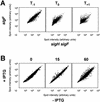Genome-wide analysis of the stationary-phase sigma factor (sigma-H) regulon of Bacillus subtilis
- PMID: 12169614
- PMCID: PMC135291
- DOI: 10.1128/JB.184.17.4881-4890.2002
Genome-wide analysis of the stationary-phase sigma factor (sigma-H) regulon of Bacillus subtilis
Abstract
Sigma-H is an alternative RNA polymerase sigma factor that directs the transcription of many genes that function at the transition from exponential growth to stationary phase in Bacillus subtilis. Twenty-three promoters, which drive transcription of 33 genes, are known to be recognized by sigma-H-containing RNA polymerase. To identify additional genes under the control of sigma-H on a genome-wide basis, we carried out transcriptional profiling experiments using a DNA microarray containing >99% of the annotated B. subtilis open reading frames. In addition, we used a bioinformatics-based approach aimed at the identification of promoters recognized by RNA polymerase containing sigma-H. This combination of approaches was successful in confirming most of the previously described sigma-H-controlled genes. In addition, we identified 26 putative promoters that drive expression of 54 genes not previously known to be under the direct control of sigma-H. Based on the known or inferred function of most of these genes, we conclude that, in addition to its previously known roles in sporulation and competence, sigma-H controls genes involved in many physiological processes associated with the transition to stationary phase, including cytochrome biogenesis, generation of potential nutrient sources, transport, and cell wall metabolism.
Figures


References
Publication types
MeSH terms
Substances
Grants and funding
LinkOut - more resources
Full Text Sources
Other Literature Sources
Molecular Biology Databases

